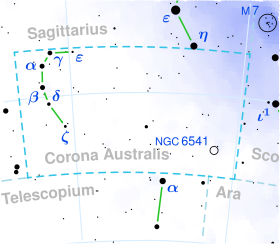Astronomy:Kappa2 Coronae Australis
| Observation data Epoch J2000.0 Equinox (celestial coordinates) | |
|---|---|
| Constellation | Corona Australis |
| Right ascension | 18h 33m 23.13130s[1] |
| Declination | −38° 43′ 33.5392″[1] |
| Apparent magnitude (V) | 5.59±0.01[2] |
| Characteristics | |
| Spectral type | B9 Vnn[3] |
| B−V color index | −0.06[4] |
| Astrometry | |
| Radial velocity (Rv) | −15.0±7.4[5] km/s |
| Proper motion (μ) | RA: −2.911[1] mas/yr Dec.: −20.468[1] mas/yr |
| Parallax (π) | 4.6115 ± 0.0747[1] mas |
| Distance | 710 ± 10 ly (217 ± 4 pc) |
| Details | |
| Mass | 3.12+0.41−0.37[6] M☉ |
| Radius | 5.28±0.28[7] R☉ |
| Luminosity | 460[8] L☉ |
| Surface gravity (log g) | 3.58±0.07[6] cgs |
| Temperature | 12,600[9] K |
| Metallicity [Fe/H] | −0.10[10] dex |
| Other designations | |
| Database references | |
| SIMBAD | data |
Kappa2 Coronae Australis (Kappa2 CrA), Latinized from κ2 Coronae Australis, is the primary of a probable binary system[12] located in the southern constellation Corona Australis. It is visible to the naked eye as a bluish-white hued star with an apparent visual magnitude of 5.59.[2] The distance to this star is roughly 710 light years based on Gaia DR3 parallax measurements.[1] The radial velocity is poorly constrained, but the star appears to be moving closer with a radial velocity of around −15 km/s.[5] At its current distance, Kappa2 CrA's brightness is diminished by 0.45 magnitudes due to interstellar dust.[13]
This is an ordinary B-type main-sequence star with a stellar classification of B9Vnn, with the nn meaning extremely nebulous absorption lines, usually due to rapid rotation.[3] It has 3.12 times the mass of the Sun[6] and a radius 5.28 times larger than the Sun,[7] which is large for stars of this type. It radiates 460 times the luminosity of the Sun from its photosphere[8] at an effective temperature of 12,600 K.[9] The large radius combined with the high luminosity of the star may indicate that Kappa2 CrA is highly evolved.[citation needed]
Kappa2 CrA forms a binary star with Kappa1 Coronae Australis, also known as HR 6952.[14] Kappa1 is located 20.5" away along a position angle of 359°.[15] The two were once thought to be an optical pair due to the large difference in their parallaxes but are now considered to be physical based on Gaia measurements. The satellite places Kappa1 and Kappa2 around 700 light years away.[1]
References
- ↑ 1.0 1.1 1.2 1.3 1.4 1.5 Vallenari, A. et al. (2022). "Gaia Data Release 3. Summary of the content and survey properties". Astronomy & Astrophysics. doi:10.1051/0004-6361/202243940 Gaia DR3 record for this source at VizieR.
- ↑ 2.0 2.1 Høg, E.; Fabricius, C.; Makarov, V. V.; Urban, S.; Corbin, T.; Wycoff, G.; Bastian, U.; Schwekendiek, P. et al. (March 2000). "The Tycho-2 catalogue of the 2.5 million brightest stars". Astronomy and Astrophysics 355: L27–L30. ISSN 0004-6361. Bibcode: 2000A&A...355L..27H.
- ↑ 3.0 3.1 Abt, Helmut A.; Morrell, Nidia I. (1995). "The Relation between Rotational Velocities and Spectral Peculiarities among A-Type Stars". Astrophysical Journal Supplement 99: 135. doi:10.1086/192182. Bibcode: 1995ApJS...99..135A.
- ↑ Corben, P. M. (April 1971). "Photoelectric Magnitudes and Colours for Bright Southern Stars". Monthly Notes of the Astronomical Society of South Africa 30 (4): 37. ISSN 0024-8266. Bibcode: 1971MNSSA..30...37C.
- ↑ 5.0 5.1 Kharchenko, N.V.; Scholz, R.-D.; Piskunov, A.E.; Röser, S.; Schilbach, E. (November 2007). "Astrophysical supplements to the ASCC-2.5: Ia. Radial velocities of ~55000 stars and mean radial velocities of 516 Galactic open clusters and associations". Astronomische Nachrichten 328 (9): 889–896. doi:10.1002/asna.200710776. ISSN 0004-6337. Bibcode: 2007AN....328..889K.
- ↑ 6.0 6.1 6.2 Stassun, Keivan G. et al. (9 September 2019). "The Revised TESS Input Catalog and Candidate Target List". The Astronomical Journal 158 (4): 138. doi:10.3847/1538-3881/ab3467. Bibcode: 2019AJ....158..138S.
- ↑ 7.0 7.1 Kervella, P.; Thévenin, F.; Di Folco, E.; Ségransan, D. (October 2004). "The angular sizes of dwarf stars and subgiants". Astronomy & Astrophysics 426 (1): 297–307. doi:10.1051/0004-6361:20035930. ISSN 0004-6361. Bibcode: 2004A&A...426..297K.
- ↑ 8.0 8.1 McDonald, I.; Zijlstra, A. A.; Boyer, M. L. (21 November 2012). "Fundamental parameters and infrared excesses of Hipparcos stars: Parameters and IR excesses from Hipparcos". Monthly Notices of the Royal Astronomical Society 427 (1): 343–357. doi:10.1111/j.1365-2966.2012.21873.x. ISSN 0035-8711. Bibcode: 2012MNRAS.427..343M.
- ↑ 9.0 9.1 Philip, A. G. D.; Egret, D. (May 1980). "An analysis of the Hauck-Mermillod catalogue of homogeneous four-color data. II.". Astronomy and Astrophysics Supplement Series 40: 199–205. ISSN 0365-0138. Bibcode: 1980A&AS...40..199P.
- ↑ Anders, F. et al. (August 2019). "Photo-astrometric distances, extinctions, and astrophysical parameters for Gaia DR2 stars brighter than G = 18". Astronomy & Astrophysics 628: A94. doi:10.1051/0004-6361/201935765. ISSN 0004-6361. Bibcode: 2019A&A...628A..94A.
- ↑ "kap02 CrA". SIMBAD. Centre de données astronomiques de Strasbourg. http://simbad.u-strasbg.fr/simbad/sim-basic?Ident=kap02+CrA.
- ↑ Eggleton, P. P.; Tokovinin, A. A. (11 September 2008). "A catalogue of multiplicity among bright stellar systems". Monthly Notices of the Royal Astronomical Society 389 (2): 869–879. doi:10.1111/j.1365-2966.2008.13596.x. ISSN 0035-8711. Bibcode: 2008MNRAS.389..869E.
- ↑ Gontcharov, George A.; Mosenkov, Aleksandr V. (28 September 2017). "Verifying reddening and extinction for Gaia DR1 TGAS main sequence stars". Monthly Notices of the Royal Astronomical Society 472 (4): 3805–3820. doi:10.1093/mnras/stx2219. ISSN 0035-8711. Bibcode: 2017MNRAS.472.3805G.
- ↑ Makarov, Valeri V. (2020). "Two-epoch Orbit Estimation for Wide Binaries Resolved in Hipparcos and Gaia". The Astronomical Journal 160 (6): 284. doi:10.3847/1538-3881/abbe1c. Bibcode: 2020AJ....160..284M.
- ↑ Mason, Brian D.; Wycoff, Gary L.; Hartkopf, William I.; Douglass, Geoffrey G.; Worley, Charles E. (December 2001). "The 2001 US Naval Observatory Double Star CD-ROM. I. The Washington Double Star Catalog". The Astronomical Journal 122 (6): 3466–3471. doi:10.1086/323920. ISSN 0004-6256. Bibcode: 2001AJ....122.3466M.
<ref> tag with name "Gould1879" defined in <references> is not used in prior text.External links
- Alcyone.de
- Alcyone.de
- Simbad.u-strasbg.fr
- Simbad.u-strasbg.fr
- Server7.wikisky.org
- Server7.wikisky.org
 |


